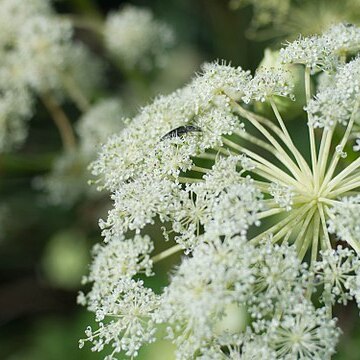Plants perennial 1–2.5 m, stout. Root cylindric, brown, 3–5 cm thick, strongly aromatic. Stem purplish green, 2–5(–7–8) cm thick, ribbed, pubescent above. Basal and lower leaves long-petiolate, sheaths oblong-inflated, glabrous; blade triangular-ovate, 30–50 × 25–40 cm, 2–3-ternate-pinnate; leaflets sessile, oblong-elliptic to oblong-lanceolate, 4–10 × 1–4 cm, base slightly decurrent, margin white-cartilaginous and coarse-cuspidate-serrate, apex acute, pubescent along nerves adaxially. Upper leaves reduced, sheaths saccate-inflated, bladeless. Umbels 10–30 cm across; peduncles 5–20 cm, scabrous; bracts absent or 1–2, like uppermost leaves; rays 18–40(–70), short-hairy; bracteoles many, linear-lanceolate, scarious; pedicels many, scabrous. Calyx teeth obsolete. Petals white, obovate and notched. Ovary glabrous or pubescent. Fruit suborbicular, 4–7 × 4–6 mm; dorsal ribs prominent, obtusely thick-rounded, much wider than furrows, lateral ribs broad-winged; vittae 1 in each furrow, 2 on commissure. Fl. Jul–Aug, fr. Aug–Sep.
More
A herb. It keeps growing from year to year. It can grow 1-2.5 m tall. The root is cylinder shaped, brown, 3-5 cm thick and has a strong smell. The stem is purplish-green. It is 2-5 cm thick and has ribs. The lower leaves have long leafstalks. The leaves are oval or triangle shaped and 30-50 cm long by 25-40 cm wide. They are divided into leaflets that are 4-10 cm long by 1-4 cm wide.
Damp habitats in mountains, C. Japan. Forest margins, valley grasslands, streamsides; at elevations from 500-1,000 metres. Banks of rivers and streams, mostly gravelly soil, shrubby thickets, along coasts, rarely meadows.
More
A cool temperate plant. In north China it grows in grasslands, along streams and near the edges of forests between 500-1,000 m above sea level.

